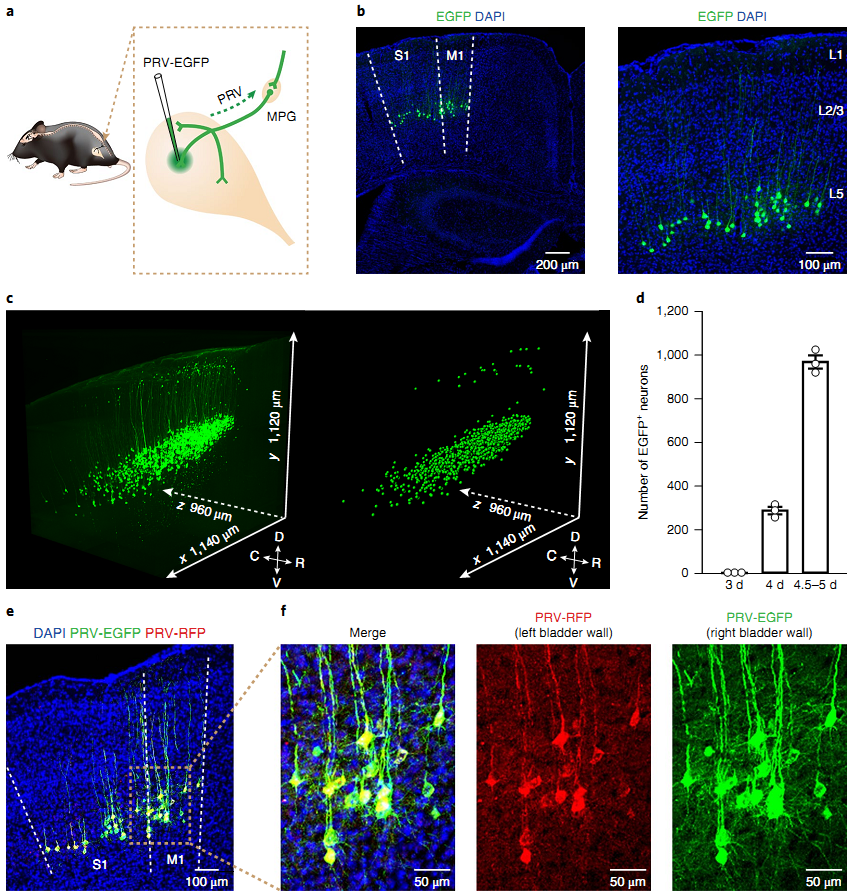AAV-hChR2 viruses were used for optogenetic activation of excitatory neurons, AAV-hM4D(Gi) virus was used for chemogenetic inhibition experiments. AAV-taCasp3 virus was used for ablating M1 L5 excitatory neurons. PRVs were used for retrograde trans-synaptic tracing experiments.
The viruses used in this article are in the table below
|
Calcium sensors |
AAV-hSyn-GCaMP6f
AAV-DIO-GCaMP6s |
|
Optogenetic |
AAV-CaMKIIα-hChR2 (H134R)-mCherry
AAV-DIO-hChR2(H134R)-mCherry |
|
Control |
AAV-hSyn-mCherry
AAV-CaMKIIα-EGFP
AAV-DIO-mCherry |
|
Chemogenetics |
AAV-CaMKIIa-hM4D(Gi)-mCherry |
|
CRE Recombinase |
AAV-CaMKIIa-Cre-GFP
AAV1-hSyn-Cre
AAV1-CMV-Cre-GFP |
|
Neuron Ablation |
AAV-CAG-DIO-taCasp3-TEVp |
|
PRV |
PRV-EGFP
PRV-RFP |
Jiwei Yao, Quanchao Zhang, Xiang Liao, Qianwei Li, Shanshan Liang, Xianping Li, Yalun Zhang, Xiangning Li, Haoyu Wang, Han Qin, Meng Wang, Jingcheng Li, Jianxiong Zhang, Wenjing He, Wen Zhang4, Tong Li, Fuqiang Xu, Hui Gong, Hongbo Jia, Xiaohong Xu, Junan Yan and Xiaowei Chen
Pub Date: 2018-10-25,
DOI: 10.1038/s41593-018-0256-4,
Email: sales@brainvta.com
Urination (also called micturition) is thought to be regulated by a neural network that is distributed in both subcortical and cortical regions. Previously, urination-related neurons have been identified in subcortical structures such as the pontine micturition center (also known as Barrington’s nucleus). However, the origin of the descending cortical pathway and how it interfaces with this subcortical circuit to permit voluntary initiation of urination remain elusive. Here we identified a small cluster of layer 5 neurons in the primary motor cortex whose activities tightly correlate with the onset of urination in freely behaving mice and increase dramatically during territorial marking. Optogenetically activating these neurons elicits contraction of the bladder and initiates urination, through their projections to the pontine micturition center, while silencing or ablating them impairs urination and causes retention of urine. Together these results reveal a novel cortical component upstream of the pontine micturition center that is critically involved in urination.
 Figure. 1 Retrograde and trans-synaptic identification of a cluster of cortical L5 pyramidal neurons after PRV injection into the bladder wall.
Figure. 1 Retrograde and trans-synaptic identification of a cluster of cortical L5 pyramidal neurons after PRV injection into the bladder wall.
The origin of the descending cortical pathway and how it interfaces with this subcortical circuit to permit voluntary initiation of urination remain elusive. To address this issue, by combining a variety of approaches, including virus-based tracing and mapping, in vivo neuronal activity recording, and functional manipulation of neuronal activities, the author discovered a small group of layer 5 (L5) neurons in the primary motor cortex (M1) that plays an essential role in the descending control of urination via their projections to the PMC. This finding provides new insights into cortical mechanisms governing urination and offers a potential brain site to target in urination-related disorders in humans.
BrainVTA offers viral vector construction & virus packaging services for AAV, LV, RABV, PRV, HSV and VSV that help researchers explore questions about genes, neurons, circuitry structure, function of brain network, mechanism and treatment of diseases.
If you have any needs, just email us at
sales@brainvta.com.
